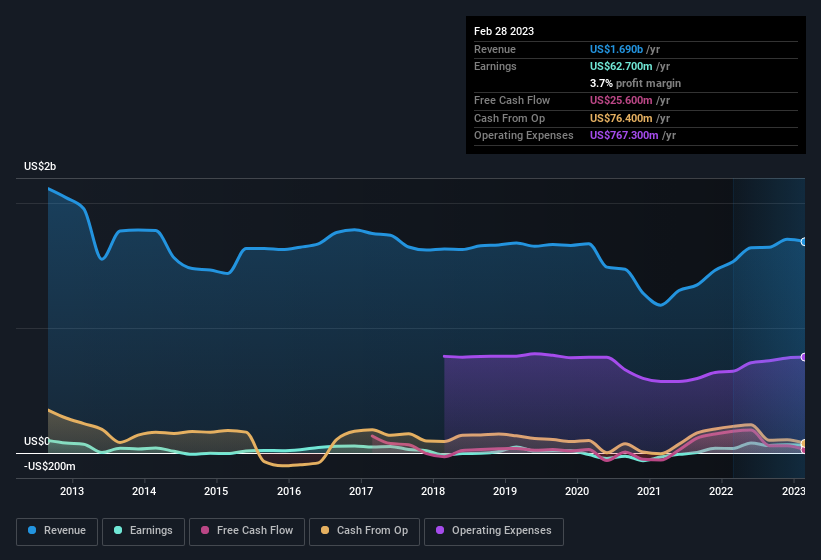- United States
- /
- Media
- /
- NasdaqGS:SCHL
We Ran A Stock Scan For Earnings Growth And Scholastic (NASDAQ:SCHL) Passed With Ease

The excitement of investing in a company that can reverse its fortunes is a big draw for some speculators, so even companies that have no revenue, no profit, and a record of falling short, can manage to find investors. But the reality is that when a company loses money each year, for long enough, its investors will usually take their share of those losses. A loss-making company is yet to prove itself with profit, and eventually the inflow of external capital may dry up.
In contrast to all that, many investors prefer to focus on companies like Scholastic (NASDAQ:SCHL), which has not only revenues, but also profits. Now this is not to say that the company presents the best investment opportunity around, but profitability is a key component to success in business.
See our latest analysis for Scholastic
How Fast Is Scholastic Growing Its Earnings Per Share?
Scholastic has undergone a massive growth in earnings per share over the last three years. So much so that this three year growth rate wouldn't be a fair assessment of the company's future. As a result, we'll zoom in on growth over the last year, instead. Outstandingly, Scholastic's EPS shot from US$1.05 to US$1.90, over the last year. It's not often a company can achieve year-on-year growth of 80%.
One way to double-check a company's growth is to look at how its revenue, and earnings before interest and tax (EBIT) margins are changing. Scholastic maintained stable EBIT margins over the last year, all while growing revenue 10% to US$1.7b. That's progress.
The chart below shows how the company's bottom and top lines have progressed over time. Click on the chart to see the exact numbers.

While profitability drives the upside, prudent investors always check the balance sheet, too.
Are Scholastic Insiders Aligned With All Shareholders?
It should give investors a sense of security owning shares in a company if insiders also own shares, creating a close alignment their interests. Shareholders will be pleased by the fact that insiders own Scholastic shares worth a considerable sum. To be specific, they have US$21m worth of shares. That's a lot of money, and no small incentive to work hard. While their ownership only accounts for 1.6%, this is still a considerable amount at stake to encourage the business to maintain a strategy that will deliver value to shareholders.
Should You Add Scholastic To Your Watchlist?
Scholastic's earnings have taken off in quite an impressive fashion. That EPS growth certainly is attention grabbing, and the large insider ownership only serves to further stoke our interest. At times fast EPS growth is a sign the business has reached an inflection point, so there's a potential opportunity to be had here. So at the surface level, Scholastic is worth putting on your watchlist; after all, shareholders do well when the market underestimates fast growing companies. Still, you should learn about the 1 warning sign we've spotted with Scholastic.
Although Scholastic certainly looks good, it may appeal to more investors if insiders were buying up shares. If you like to see insider buying, then this free list of growing companies that insiders are buying, could be exactly what you're looking for.
Please note the insider transactions discussed in this article refer to reportable transactions in the relevant jurisdiction.
New: Manage All Your Stock Portfolios in One Place
We've created the ultimate portfolio companion for stock investors, and it's free.
• Connect an unlimited number of Portfolios and see your total in one currency
• Be alerted to new Warning Signs or Risks via email or mobile
• Track the Fair Value of your stocks
Have feedback on this article? Concerned about the content? Get in touch with us directly. Alternatively, email editorial-team (at) simplywallst.com.
This article by Simply Wall St is general in nature. We provide commentary based on historical data and analyst forecasts only using an unbiased methodology and our articles are not intended to be financial advice. It does not constitute a recommendation to buy or sell any stock, and does not take account of your objectives, or your financial situation. We aim to bring you long-term focused analysis driven by fundamental data. Note that our analysis may not factor in the latest price-sensitive company announcements or qualitative material. Simply Wall St has no position in any stocks mentioned.
About NasdaqGS:SCHL
Scholastic
Scholastic Corporation publishes and distributes children’s books worldwide.
Undervalued with excellent balance sheet and pays a dividend.

